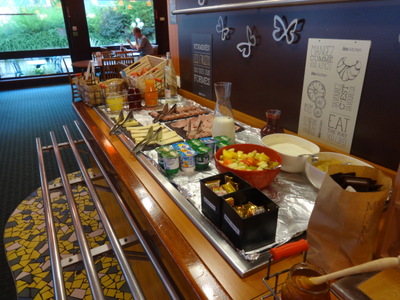
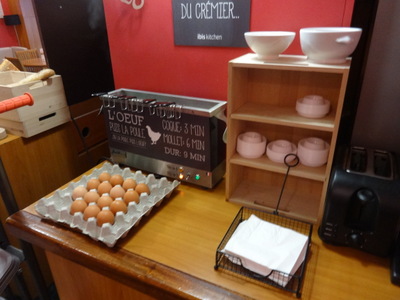 I shouldn't malign the Ibis breakfast. I'm just as glad all the little nutritional signs are gone; just one remains, near the bread—"gluten-free items available on request."
I shouldn't malign the Ibis breakfast. I'm just as glad all the little nutritional signs are gone; just one remains, near the bread—"gluten-free items available on request." Thursday, 14 July 2016, La Bastille de Grenoble, then Grenoble to Le Bourget-du-Lac
Written 2 August 2016

 I shouldn't malign the Ibis breakfast. I'm just as glad all the little nutritional signs are gone; just one remains, near the bread—"gluten-free items available on request."
I shouldn't malign the Ibis breakfast. I'm just as glad all the little nutritional signs are gone; just one remains, near the bread—"gluten-free items available on request."
All the Ibis breakfasts we encountered on this trip included small warm crĉpes (one place even put a little bottle of pancake syrup next to them; not really the same, but at least they're trying), and this one had warm madeleines as well (served in madeleine molds, as though to imply "freshly baked," but the seemed a little large to have been baked in those pans).
They also provided a simmering water bath in which to boil eggs, and I must say that the all the eggs we encountered on this trip were excellent—so much more flavor than American supermarket eggs. And there were lots of little condiments and sprinkles—single-serve Nutella cups; salted and unsalted butter; raspberry chips, spice-cookie crumbs, and a mixture of edible seeds to sprinkle over cereal; several kinds of dried fruit; Bonne Maman jams ad lib from the jar. Really pretty good.
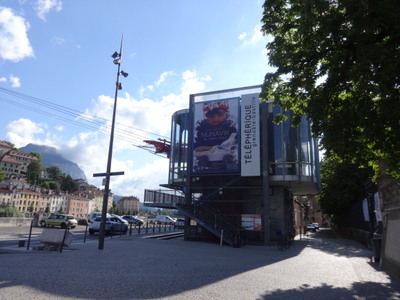 the mountain
the mountain
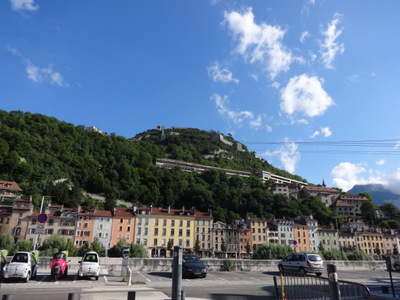 d
Happily, the weather cooperated. The day dawned clear and bright, and we could see clearly all the way to the top of the mountain across the river, so after checking out and putting our luggage in the baggage room, we we strolled the couple of blocks to the near bank of the Isère to take the "télépherique" up to the Bastille.
d
Happily, the weather cooperated. The day dawned clear and bright, and we could see clearly all the way to the top of the mountain across the river, so after checking out and putting our luggage in the baggage room, we we strolled the couple of blocks to the near bank of the Isère to take the "télépherique" up to the Bastille.
The left-hand photo shows the sleek modern station, and the one at the right shows the cables heading off toward the Bastille, which is below the top of the right-hand of the two moutain tops. Below it on the mountain side, you can see the strictly rectilinear buildings of the abandoned university site. At ground level, you can see, at the lower left corner of the photo, a row of tiny electric cars, plugged into their chargers, awaiting their users for the day. The river just beyond the concrete wall they are parked against, between us and the buildings beyond.
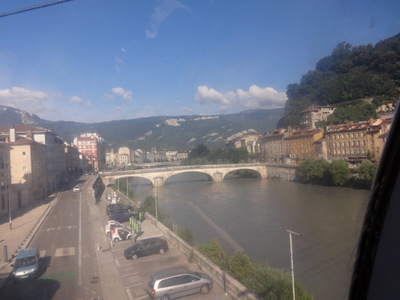
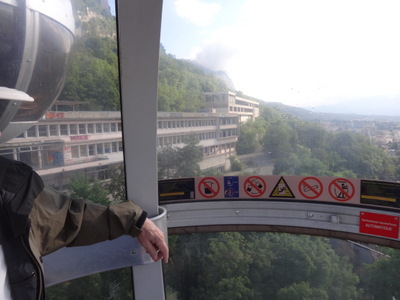 This was the very first urban cablecar in France, opened in 1934. All its components have been replaced at intervals, but this year is proudly trumpeted as the 40th birthday of the "bulles," the plastic bubbles currently in use as passenger compartments. Unfortunately, their age shows in the lost transparency of their plastic walls.
This was the very first urban cablecar in France, opened in 1934. All its components have been replaced at intervals, but this year is proudly trumpeted as the 40th birthday of the "bulles," the plastic bubbles currently in use as passenger compartments. Unfortunately, their age shows in the lost transparency of their plastic walls.
In these views from our "bulle," one of the view as we started up, over the river, and the other showing a closer view of the old university buildings, you can see how cloudy they have become. Too bad, as the views must truly have been spectacular when they were new and perfectly clear.
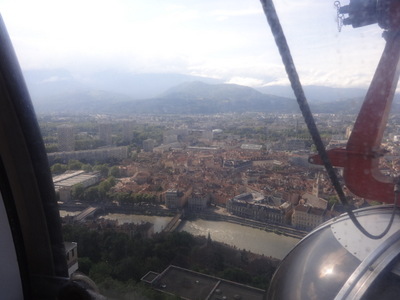
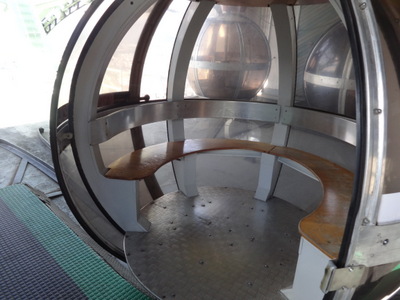 In this view from near the top, you can see (besides the flat roofs of the old university buildings at the bottom edge) the division between the old city, with its red tile roofs, and the newer sections surrounding it. The very large rectilinear white building at the center left is the art museum we spent Wednesday afternoon in, and our restaurant of last night is right across from it, at the very edge of the old city.
In this view from near the top, you can see (besides the flat roofs of the old university buildings at the bottom edge) the division between the old city, with its red tile roofs, and the newer sections surrounding it. The very large rectilinear white building at the center left is the art museum we spent Wednesday afternoon in, and our restaurant of last night is right across from it, at the very edge of the old city.
Here's a view of the bulle we've just gotten out of, with benches around the sides. Others had a central post with seats arranged around it, facing outward. We rode that kind back down.
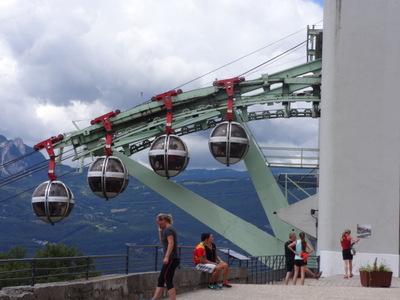
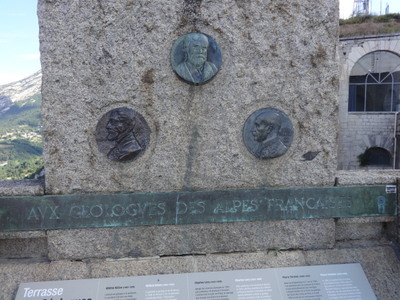 Here's the best view I got of a train of bulles arriving at the upper station. When crowds are large, they can add extras, to form groups of five, but we were there early, and traffic was light, so we had a bulle to ourselves, and one of our group was empty.
Here's the best view I got of a train of bulles arriving at the upper station. When crowds are large, they can add extras, to form groups of five, but we were there early, and traffic was light, so we had a bulle to ourselves, and one of our group was empty.
We started with the "Plateau of the Geologists," a flat space east of the cable-car station that's dedicated to Wilfrid Kilian (1862–1925, long-time professor in Grenoble), Charles Lory (1823–1889, also long-time professor in Grenoble) and Pierre Termier (1859–1930, School of Mines in Paris), the three scientists who elucidated the geology of the Alps. The whole plateau, like several of the other spaces in the Bastille, was ringed with panels showing diagrams of the faulting that produced the surfaces we could see from the before us.
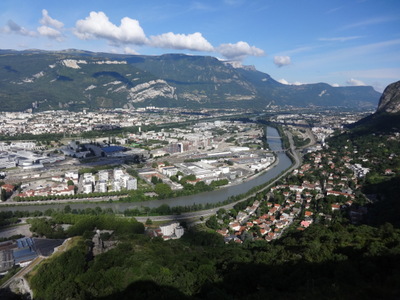
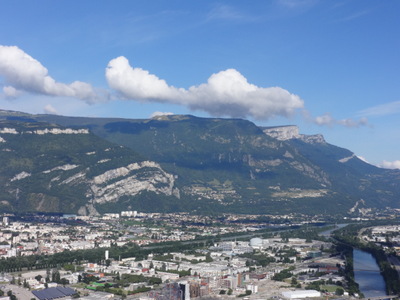 In this view of the city, facing more toward the east (the old town is just out of the frame to the left; you can just see a few of its tile roofs at the photo's left-hand edge). On the mountain sides in the distance you can see some of the folding and faulting discussed in the panels. The river at the lower right is the Isère. The Drac is visible as a double row of trees crossing the city about half way to the bases of the mountains. The confluence is just out of sight at the right-hand edge.
In this view of the city, facing more toward the east (the old town is just out of the frame to the left; you can just see a few of its tile roofs at the photo's left-hand edge). On the mountain sides in the distance you can see some of the folding and faulting discussed in the panels. The river at the lower right is the Isère. The Drac is visible as a double row of trees crossing the city about half way to the bases of the mountains. The confluence is just out of sight at the right-hand edge.
Here's a better shot of the confluence. The long peninsula between the two rivers is called the "Polygone Scientifique" and is home to many scientific research institutes. As far as I can tell, the Grenoable High Magnetic Field Lab is just at the middle of the bottom edge of the photo.
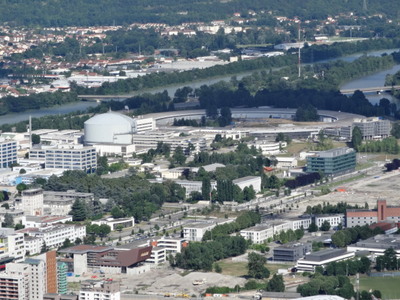
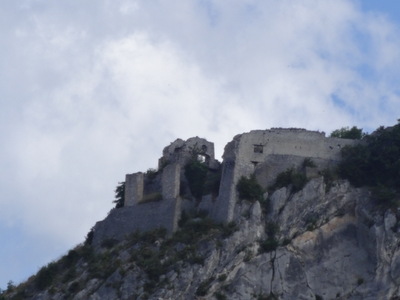 Finally, here's an even closer shot of the end of the peninsula. The prominent ring is the European Cyclotron.
Finally, here's an even closer shot of the end of the peninsula. The prominent ring is the European Cyclotron.
And the Bastille is not the only fortification to occupy the mountain. Here's a telephoto looking upward toward the peak from Bastille level, showing the ruins of an older fort or castle higher up.
The hill the Bastille sits on is the southernmost point of the Chartreuse range, and in the early 16th century, both François I and and Charles IX had asked for it to be fortified, but it didnt' get done. When Lesdiguières took over, in the late 16th century, he finally built a fort up there burt not a very convincing one. Under Louis XIV, late in the 17th century, Vauban came through and drew up plans for a serious fortification (he was pretty dismissive of the existing one), suited for defense against artillery, but again, those plans were never acted on.
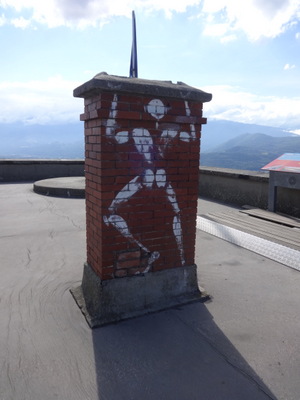
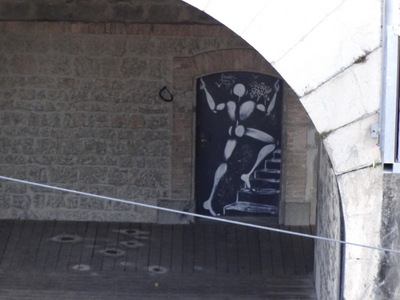 Finally, in the early 19th century, Grenoble found itself on the frontier. France ended there, and beyond was the Savoie, part of the Kingdom of Piedmont-Sardaigne, so General Haxo was sent to fortify the place seriously, but with fortifications facing the Chartreuse Mountains rather than the city. The construction took quite a while, and just a few years after it was finished, Savoy became part of France and the frontier disappeared! (Nice joined France in the same transaction, around 1860.)
Finally, in the early 19th century, Grenoble found itself on the frontier. France ended there, and beyond was the Savoie, part of the Kingdom of Piedmont-Sardaigne, so General Haxo was sent to fortify the place seriously, but with fortifications facing the Chartreuse Mountains rather than the city. The construction took quite a while, and just a few years after it was finished, Savoy became part of France and the frontier disappeared! (Nice joined France in the same transaction, around 1860.)
Another wide flat space, up a level or two from the pleateau of geologists is the "Belvedere Vauban, where we spent a while admiring and photographing the view and studying the improved design of the gun emplacements (Haxo figured out a better way to ventilate them to provent smoke build-up during firing).
Apparently an acrobatic troupe sometimes performs there—some of their rigging was folded away in the corners, and we were delighted to find that our old friend Nemo, the wonderful graffiti artist we came to know and love in the 20th arrondissement of Paris, had been there! These photos show two of his works on the belvedere level. Only the white figure appeared; he didn't bring along his friend in the black trenchcoat. (And, no, Nemo is not named for the orange striped clownfish or even for the captain of the Nautilus; his name comes straight from the Latin, where it means "no one.")
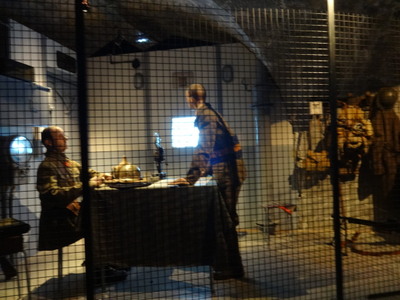
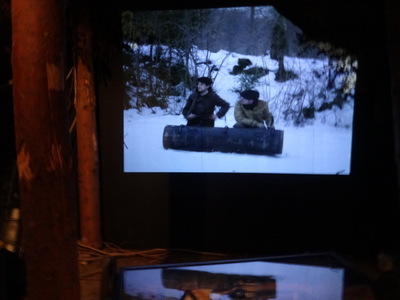 The Bastille and its hill are home to several museums and many more architecture features than we had time to visit. We were there on a holiday, so not everything was open, but what we came across and had time for was the Museum of the French "Chasseurs Alpins," literally "Alpine Hunters," France's elite alpine military unit.
The Bastille and its hill are home to several museums and many more architecture features than we had time to visit. We were there on a holiday, so not everything was open, but what we came across and had time for was the Museum of the French "Chasseurs Alpins," literally "Alpine Hunters," France's elite alpine military unit.
The unit was formed at the end of the 19th century to fend off threats from the other side of the Alps, and it's still active today. One of its three battalions is based in Grenoble (the other two are in Chambéry, which we drove through a couple of times, and Annecy, which we visited later on this trip.
The museum was terrific, using an automatic (i.e., hands-free, no controls) style of audioguide, holograms, and movies, in addition to the usual static displays and mannekins. Actually military personel man the reception desk.
Members undergo rigorous training in urban warfare as well as alpine winter maneuvers. The unit produces outstanding skiers—Jean-Claude Killy came to the Olympics via the Chasseurs Alpins.
The photo at the right here is of a scene from a short movie about the Resistance in WWII. Apparently, when France came under German domination and occupation, much of the just took to the hills and became resistance fighters.
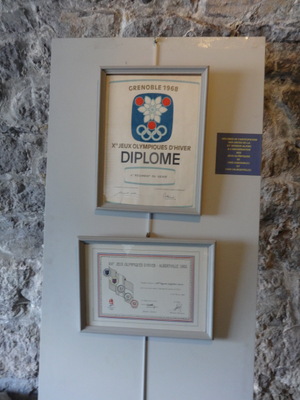
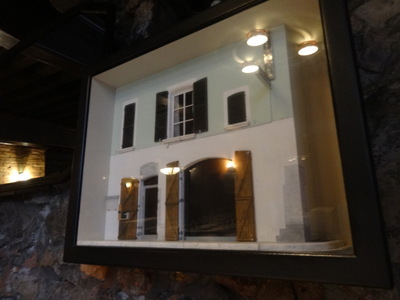 The documents shown at the left here are "diplomas" awarded to the unit for its work on the 1968 (Grenoble) and 1992 (Albertville) winter olympics. Accustomed working under winter conditions, they were called upon to construct things like the ski jumps and bobsled runs for the games. Movie clips showed the process.
The documents shown at the left here are "diplomas" awarded to the unit for its work on the 1968 (Grenoble) and 1992 (Albertville) winter olympics. Accustomed working under winter conditions, they were called upon to construct things like the ski jumps and bobsled runs for the games. Movie clips showed the process.
They've also been deployed as fighters and UN peacekeepers in Afganistan and in Africa.
I highly recommend that museum to anyone who visits the Bastille; I wish we'd had time for all the other attractions in the area.
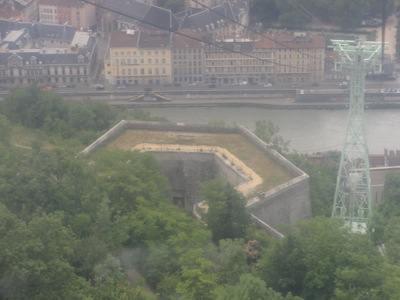
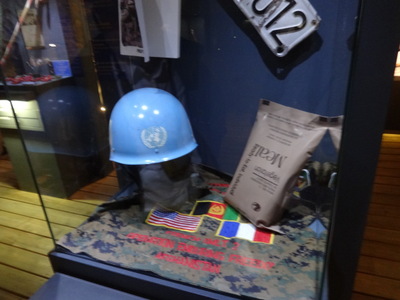 On the way back down in the cablecar, I got this shot, from above, of a Vauban-style corner bastion. Never needed for defense, but a nice picnic spot with a view over the city.
On the way back down in the cablecar, I got this shot, from above, of a Vauban-style corner bastion. Never needed for defense, but a nice picnic spot with a view over the city.
Back down in the city, we tried to get lunch at l'Iridescent, where we ate the first day, but it was closed for Bastille Day. (Though I'm told that one no longer saysm "Happy Bastille Day." Now it should be "Happy 14 July" or better "Happy National Festival." When we passed about the 15th sheep, all clearly painted by the same hand, peeking out as though around a corner on the side of a building, I gave in and took this photo. No idea what they are apropos of.
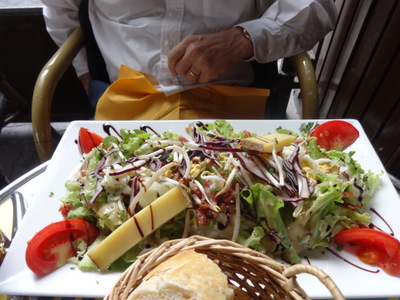
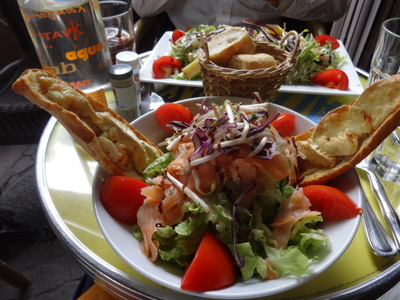 We finally chose the "Coq Hardi," which I had actually just taken a telephoto of from up on the mountain, because it was just around the corner from the Ibis, I could just barely make out the tiny red "Ibis" sign above the parking garage.
We finally chose the "Coq Hardi," which I had actually just taken a telephoto of from up on the mountain, because it was just around the corner from the Ibis, I could just barely make out the tiny red "Ibis" sign above the parking garage.
David ordered the "salade paysanne" (eggs, croutons, lardons, and comté cheese). I chose the "salade de la mer," topped, as you would expect from the name, with smoked salmon, but also including, entirely unexpectedly, two large toasts covered with grilled goat cheese. Great combination, but usually served only in separate salads.
From there, we headed back to the hotel for our luggage, got the car out of the garage, and headed for our next destination, Le Bourget-du-Lac. After the lovely sunny morning, the first rain drops fell as we pulled out of town.

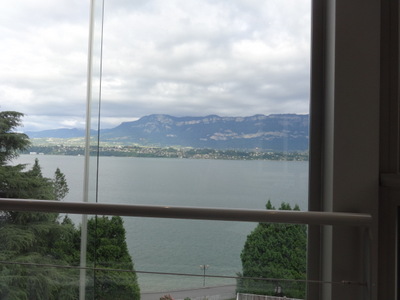 Le Bourget is on the western side of the lower end of the long, north-south Lac du Bourget, one of France's two major alpine lakes. It has a long compound name to distinguish it from the Le Bourget near Paris where Lindberg landed The Spirit of St. Louis.
Le Bourget is on the western side of the lower end of the long, north-south Lac du Bourget, one of France's two major alpine lakes. It has a long compound name to distinguish it from the Le Bourget near Paris where Lindberg landed The Spirit of St. Louis.
We're at the Savoy Hotel, written just like that, in English. The rooms are unairconditioned and on the third floor. No elevator, and those are tall floors (with 10-foot ceilings). Sigh. Once we'd dragged the bags up the stairs, though, it wasn't bad at all. Once I propped the shutters open, the temperature was pleasant; since the rain, the weather has turned cool, and the hotel has its own outdoor parking lot.
The view from my window is of a a wooded hillside (I face away from the lake) dotted with vacation houses—definitely chalet-like. I spotted the first magpie of the trip.
The right-hand photo shows the view of the lake from our restaurant of the evening.
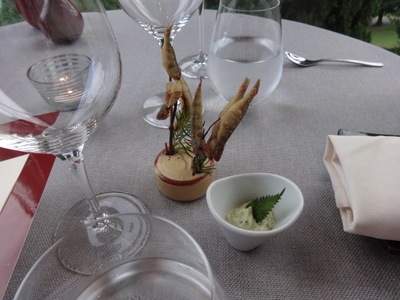
Dinner was at "Le Bateau Ivre," "the drunken boat." This was the restaurant that brought us to Le Bourget—when David picked it out(from the 2013 Gault-Millau guide),it was in the mountaintop ski resort of Courchevel, but when I looked it up to make reservations, I found that it had moved down to the lakeside.
This was the first restaurant of the trip that we had to drive to (all of 3 minutes from the hotel), which meant that I would have to drive back, and I wanted a good image of the route in mind beforehand, so I Google-mapped it in advance before we left home. Good thing, too, as the the GPS assured us that we had reached our destination when in fact, we had reached the turn off the busy highway that led to our destination, nearly a mile away! We would have been baffled, since nothing was in sight except woods, and the same would have been true when we overshot, turned around, and came back. I, however, knew that we were supposed to turn right at that point, though we only found out on the ground that we then had to thread our way down a hair-raisingly steep and narrow little road (not one-way, but not wide enough for two cars) between stone walls to the restaurant on the lakeshore.
David pulled into the parking lot and waited a moment for his pulse to steady before announcing that we weren't going back that way!
Written 13 August 2016
The first amuse-bouche was a friture of "perchot," i.e., very tiny perch, from the lake,gutted but otherwise intact. Each one was impaled on a rosemary twig for convenience of frying and eating, and they were served with a greenish herbal mayo. David yielded his portion to me.
The second amuse-bouche was an egg yolk, served in the egg shell, with little bit of smoked lavaret, and an emulsion of green pease on top. The eggshell was set on a nest of hay, herbs, or some such vegetation, which was set on fire and covered with an inverted bowl of slightly smaller size. The whole assembly was brought to the table, and the upper bowl was whisked away to reveal the egg resting in a cloud of tasty smoke. Lavaret is Coregonus lavaretus (a salmonid), the variety/species (depending on who you ask) of whitefish endemic to the Lac du Bourget.
The third amuse-bouche was a drinkable green emulsion of fresh tomato. Tasty, but I forgot to photograph it.
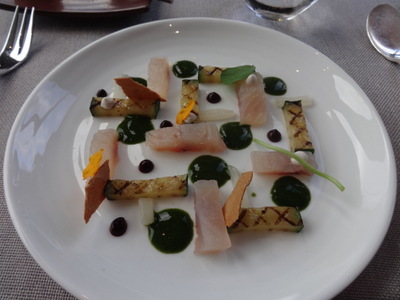
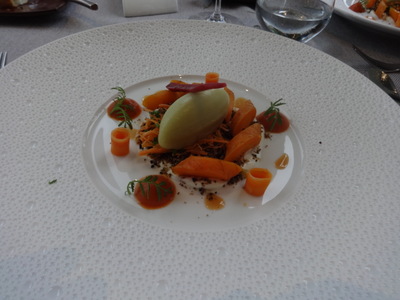 We chose the "Menu Verlaine" (the menus were named for poets, presumably those of local interest). The first listed course was smoked lavaret arranged in this interesting latticework pattern with strips of grilled cucumber, little blocks of some white vegetable (maybe poached cucumber?), and splodges of a purée of spinach and sorrel, smaller ones of a mayo-like sauce, and medium-sized ones of beet purée. A few marigold petals, shards of crisp cracker, and disks of spinach leaf were scattered over the top.
We chose the "Menu Verlaine" (the menus were named for poets, presumably those of local interest). The first listed course was smoked lavaret arranged in this interesting latticework pattern with strips of grilled cucumber, little blocks of some white vegetable (maybe poached cucumber?), and splodges of a purée of spinach and sorrel, smaller ones of a mayo-like sauce, and medium-sized ones of beet purée. A few marigold petals, shards of crisp cracker, and disks of spinach leaf were scattered over the top.
The second course was carrots (grilled, poached, and raw) served on a bed of "olive humus" (that's humus as in compost, not the chickpea purée) and topped with a quenelle of (nonsweet) vegetable sorbet and a strip of purple carrot. Sweetish carrot purée on the side.
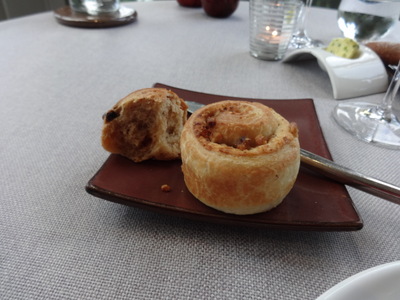
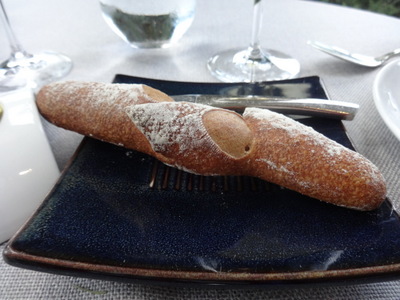
Throughout the meal, three breads were offered: black olive, "feuilleté" with walnuts, and miniature "epi" baguettes.
At the left, are the first two, on my bread plate (in the background, you can see the butter, flavored with yuzu, flat parsley, and piment d'Espellette. At the right is David's choice, the little baguette snipped with scissors to resemble an ear ("epi") of wheat. It's so short, that the ear doesn't have many grains on it.
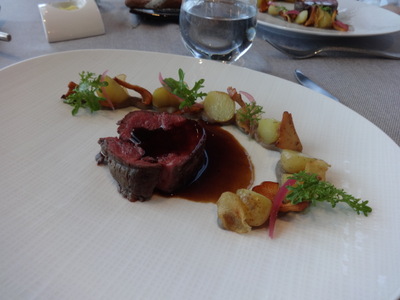
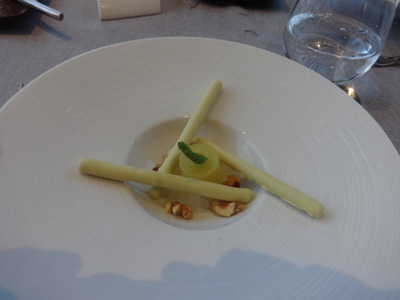 Next came beef, a thick slice of the rare, slow-roasted dry-aged filet, napped with a rich reduction sauce flavored with black garlic. Around the sides, boiled new potatoes alternated with tiny house-made potato chips, slivers of red onion, and sautéed chanterelle mushrooms. Yummy!
Next came beef, a thick slice of the rare, slow-roasted dry-aged filet, napped with a rich reduction sauce flavored with black garlic. Around the sides, boiled new potatoes alternated with tiny house-made potato chips, slivers of red onion, and sautéed chanterelle mushrooms. Yummy!
Then came the cheese course, described on the menu as "Mikado de Bleu des Aillons." Know what those skinny white "batons," thinner than pencils, consist of? Are you ready? White-chocolate-coated blue cheese! And very delicious they were, too! No clue why they should be called a "Mikado" or for that matter how in the world the chef made them. Good idea, though; at home, I might try a more easily handled shape, like cubes. The little brown things with them are roasted hazelnuts.
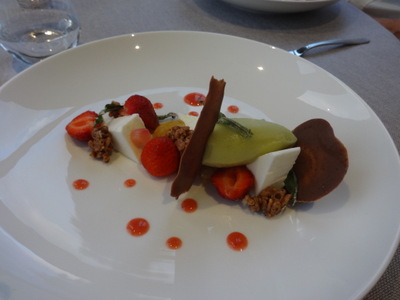
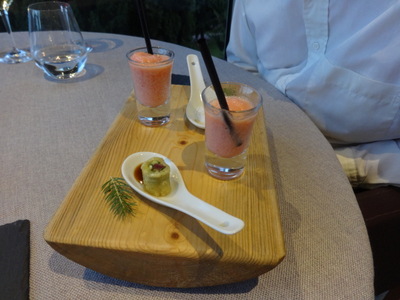 The listed dessert was "strawberries from Tremblay with lemon verbena sorbet." The white wedges seemed to be house-made marshmallow, the flat items were sheets of chocolate, and the small nubbly brown things are clusters of chocolate-coated rice krispies!
The listed dessert was "strawberries from Tremblay with lemon verbena sorbet." The white wedges seemed to be house-made marshmallow, the flat items were sheets of chocolate, and the small nubbly brown things are clusters of chocolate-coated rice krispies!
That was followed by the unannounced postdessert, which I don't remember the description of. I do remember that the granité (i.e., soft, grainy sorbet), grapefruit flavored maybe?, was too alcoholic for me.
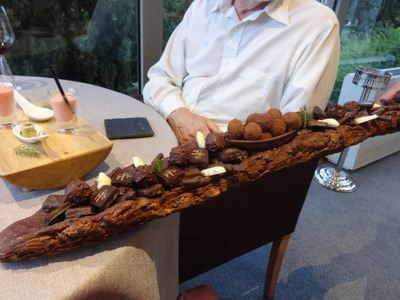
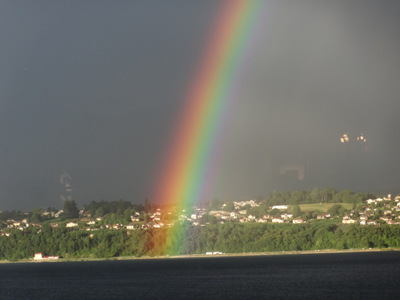 The postpostdessert was this slab of tree bark paved in house-made cocolates and truffles. The amazing thing is that we ate some of them! This was the first evening meal of the trip where the portion size was so controlled that I did not feel overfed at the end. Nice folks, great food.
The postpostdessert was this slab of tree bark paved in house-made cocolates and truffles. The amazing thing is that we ate some of them! This was the first evening meal of the trip where the portion size was so controlled that I did not feel overfed at the end. Nice folks, great food.
And great scenery. In the course of the meal, from the restaurant's windows over the lake, we watched a heavy rain storm sweep majestically down the far shore, from north to south, dragging behind it this gorgeous and everchanging rainbow. Magnificent.
Fortunately, rather than climbing back up the twisty little road that brought us, we were able to follow the road that hugged the shore of the lake and to emerge right behind the hotel. Another time, that's what I would recommend. Drive down the side road along the north wall of the hotel, then take a left on the lakeshore road and follow it to the restaurant.